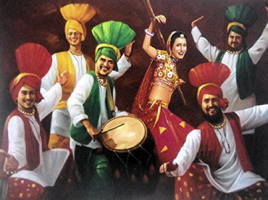
|
Folk Dance Federation of California, South, Inc.
|

|
CLICK AN IMAGE TO ENLARGE
Dance in India can be grouped into three major classifications: tribal, folk, and classical.
The tribal dance is visibly an expression of the joys and beliefs of the people once referred to as "aborigines," but now called "advasis" or original inhabitants. To these people, who live simply, some in forest areas, some on the plains, some in the jungles close by the Burmese frontier, or at the foot of the Himalayas, life is somewhat of a ritual – and dance is a natural part of it. The folk dances are, to a degree, similar except less ritualistic, and run the gamut of the everyday life of the mass of the peasants of the land in reflecting their activities. Classical dance is, in turn, rooted in the background of both, but has a style that has evolved through generations of extremely exacting study and training – to an extent where a vast library of resource material, so to speak, is to be found, with a detailed explanation for even the slightest movement, such as extending a hand or lifting an eyebrow.
In Africa, it is said that the tribes and their beliefs are recognized through the beat of the drum or the rhythm of the dances. This may be said to be true of the tribes of India as well. To them, dance is more than a form of entertainment or an outlet for physical or emotional exuberance. It is their religion. Success in the hunt, in battle, in the harvest, on the birth of an heir, perhaps the dispersion of evil forces or pestilence, desirable weather conditions, even satisfaction in love, these all can depend upon the proper and accurate performance and interpretation of the dance. Whatever form the dance may take, it is not so much a means of entertainment as it is a ritual in which both dancer and spectator are participating.
 In the folk dance of India, although derived originally from the tribal dance in many cases, the religious and ritualistic element is receding rapidly, barring, naturally, those that are part of the traditional festivals. Folk dance, however, remains a medium for the spontaneity and for the expressions of the simple joys of the people and acts as an accompaniment ot their many activities. Relaxing completely to the pleasures and ease of the dances, they may celebrate a wedding or a birth, pay homage to the advent of spring, or give thanks for a welcome rainfall, meet for a harvest, or at the conclusion of a tiger hunt, or, of course, celebrate one or all of the many national and holy festivals.
In the folk dance of India, although derived originally from the tribal dance in many cases, the religious and ritualistic element is receding rapidly, barring, naturally, those that are part of the traditional festivals. Folk dance, however, remains a medium for the spontaneity and for the expressions of the simple joys of the people and acts as an accompaniment ot their many activities. Relaxing completely to the pleasures and ease of the dances, they may celebrate a wedding or a birth, pay homage to the advent of spring, or give thanks for a welcome rainfall, meet for a harvest, or at the conclusion of a tiger hunt, or, of course, celebrate one or all of the many national and holy festivals.
In the Himalayan foothills and valleys of Uttar Pradesh or Bihar, the peasants in tehir homespun garb, embellished with whatever silver they may possess, dance the Shapdo or Pangi. Far to the east, between the tea plantations of Assam and the jungles of Burma, the women of Manipur dance the Mandala Nritya or welcome the spring to the beat of native drums and the singing of a chorus. In Rajasthan, the fierce warrior whirls to the beat of the giant drums, or there is perhaps a gentle Ras Leela by couples with their sticks, from the region of Ajmeer. The Banjara dances of Rajasthan are simple yet vivid with color, and the brilliantly patterned costumes make them most picturesque. In Punjab, one of the most popular dances is the Bhangra, full of humor and vitality. This is a community dance in which all dancers whirl around, clapping and shouting with joy. It is a seasonal dance that starts at the sowing and ends with the harvest of the grain. Far to the south, in Madras, the women dance their Pinnal Kolattam (rope dance). In Goa, the influence of the Portuguese may be seen as the dances take on a certain Iberian coloring. In fact, the Goans are probably the only people of India who celebrate Carnival. In Gujarat State, far to the west, the women dance in their beautiful costumes, quite unaware that their Garba dance is really a very old fertility rite.
The dances of India, folk dances that is, seem to reflect an environmental quality in which the movements, patterns, and group formation of the dancers conform to climatic or physical surroundings. Swaying movements of the north could represent the rolling hills and vales of the Himalayas and Kashmir; the sudden changes of pace that interrupt the normal gentility of Manipuri dances (Jagoi) denote the sudden thunderstorms that deluge that most-rainy-spot on earth; the stealthy and taught dances of Nagaland and the Gonds of Orissa, indicate the perils of the jungle; while the fishermen's dances on the shores of the Bay of Bengal are remindful of the waves of the sea. There is a similarity in steps and themes of many dances from widely divergent areas of India, but there is no monotony. The costumes, ornaments, and decorations, as well as the songs and the instruments, especially the drums, which differ from village to village and state to state, make a vast variety, but still the dance in itself seems to be a method of bringing the people together.
There are not too many opportunities of seeing these dances in the big cities. One must go into the country, as seems to be the case the world over. During national holidays, however, such as Republic Day and Independence Day, dancers from all over the nation may be seen at the National Stadium, and in the parades and processionals in New Delhi. In the states, there are celebrations on a local level, when, on holy and religio-secular holidays, such as Holi, Jeel, Dipvali and Dussehra, dance, song, and especially costumes of gorgeous splendor may be seen and heard. In Kerala there is the famous classical Kathkali.
As for classical dance, which is deeply rooted in folk and tribal dance – but that is another story, and one far more involved!
Printed in Folk Dance Scene, March 1974.